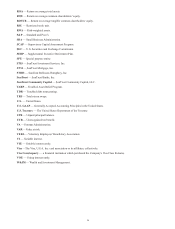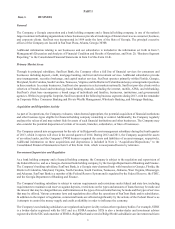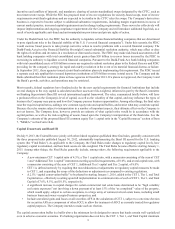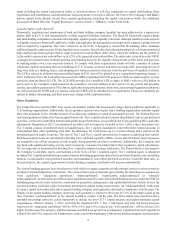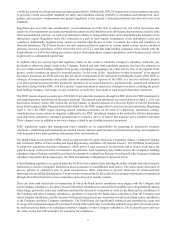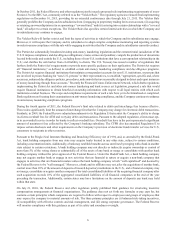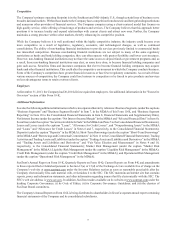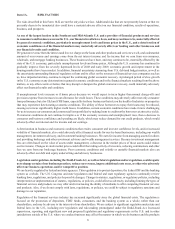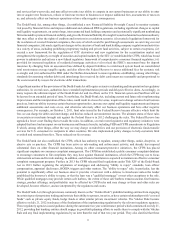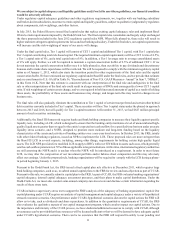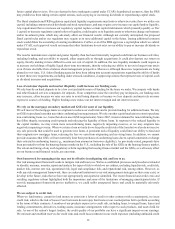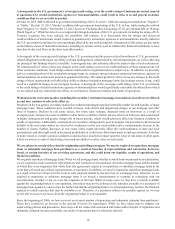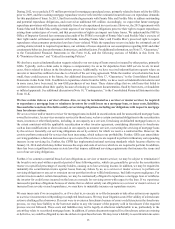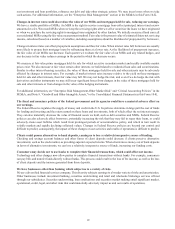SunTrust 2013 Annual Report Download - page 25
Download and view the complete annual report
Please find page 25 of the 2013 SunTrust annual report below. You can navigate through the pages in the report by either clicking on the pages listed below, or by using the keyword search tool below to find specific information within the annual report.9
and services that we provide, and may affect or restrict our ability to compete in our current businesses or our ability to enter
into or acquire new businesses, reduce or limit our revenue in businesses or impose additional fees, assessments or taxes on
us, and adversely affect our business operations or have other negative consequences.
The Dodd-Frank Act, among other things, (i) established a new Financial Stability Oversight Council to monitor systemic
risk posed by financial firms and imposes additional and enhanced FRB regulations, including significant changes to capital
and liquidity requirements, on certain large, interconnected bank holding companies and systemically significant nonbanking
firms intended to promote financial stability, and gives the Financial Stability Oversight Council substantial resolution authority
that may affect or alter the rights of creditors and investors in a resolution scenario; (ii) created a liquidation framework for
the resolution of covered financial companies, the costs of which would be paid through assessments on surviving covered
financial companies; (iii) made significant changes to the structure of bank and bank holding company regulation and activities
in a variety of areas, including prohibiting proprietary trading and private fund activities, subject to certain exceptions; (iv)
created a new framework for the regulation of OTC derivatives and new regulations for the securitization market and
strengthened the regulatory oversight of securities and capital markets by the SEC; (v) established the CFPB, which has broad
powers to administer and enforce a new federal regulatory framework of comprehensive consumer financial regulation; (vi)
provided for increased regulation of residential mortgage activities; (vii) revised the FDIC's assessment base for deposit
insurance by changing from an assessment base defined by deposit liabilities to a risk-based system based on consolidated
total assets minus average tangible equity, and also allows the Federal Reserve to assess additional fees for systemic risk
oversight, and (vii) authorized the FRB under the Durbin Amendment to issue regulations establishing, among other things,
standards for assessing whether debit card interchange fees received by debit card issuers are reasonable and proportional to
the costs incurred by issuers for electronic debit transactions.
A significant number of the provisions of the Dodd-Frank Act still require extensive rulemaking and interpretation by regulatory
authorities. In several cases, authorities have extended implementation periods and delayed effective dates. Accordingly, in
many respects the ultimate impact of the Dodd-Frank Act and its effects on the U.S. financial system and SunTrust will not
be known for an extended period of time. Nevertheless, the Dodd-Frank Act, including current and future rules implementing
its provisions and the interpretation of those rules, could result in a loss of revenue, require us to change certain of our business
practices, limit our ability to pursue certain business opportunities, increase our capital and liquidity requirements and impose
additional assessments and costs on us, and otherwise adversely affect our business operations and have other negative
consequences. For example, on October 1, 2011, final rules issued by the Federal Reserve became effective which limit the
fees we can charge for debit card interchange, and this has reduced our noninterest income. The ultimate status of these rules
is uncertain as merchants brought suit against the Federal Reserve in 2012 challenging the rules. The Federal Reserve has
appealed a lower court finding that set aside the rules. In addition, several recent legislative and regulatory initiatives were
adopted that have had an impact on our businesses and financial results, including FRB and CFPB amendments to Regulation
E which, among other things, affect the way we may charge overdraft fees and our provision of electronic funds transfer
services for U.S. consumers to recipients in other countries. We also implemented policy changes to help customers limit
overdraft and returned item fees. These reduced our fee revenue.
The Dodd-Frank Act also established the CFPB, which has authority to regulate, among other things, unfair, deceptive, or
abusive acts or practices. The CFPB has been active in rule-making and enforcement activity, and already has imposed
substantial fines on other financial institutions. Among its other consumer-protective initiatives, the CFPB has placed
significant emphasis on consumer complaint management. The CFPB has established a public consumer complaint database
to encourage consumers to file complaints they may have against financial institutions, which the CFPB may use to focus
enforcement actions and for rule-making. In addition, each financial institution is expected to maintain an effective consumer
complaint management program. Further, in 2013 the CFPB released final regulations under Title XIV of the Dodd-Frank
Act in 2013 further regulating the origination of mortgages and addressing "ability to repay" standards, loan officer
compensation, appraisal disclosures, HOEPA triggers and other matters. The "ability to repay" rule, in particular, has the
potential to significantly affect our business since it provides a borrower with a defense to foreclosure unless the lender
established the borrower's ability to repay, or that the loan was a "qualified mortgage" or met other exceptions to the rule.
While qualified mortgages may provide certain safe harbors, the extent of these safe harbors remains unclear. Our business
strategy, product offerings, and profitability may be affected by CFPB rules and may change as these and other rules are
developed, become effective, and are interpreted by the regulators and courts.
The Dodd-Frank Act (through provisions commonly known as the “Volcker Rule”) prohibits banking entities from engaging
in certain types of proprietary trading and restricts their ability to sponsor, invest in, or have certain relationships with “covered
funds” such as private equity funds, hedge funds or other similar private investment vehicles. The Volcker Rule became
effective on July 21, 2012 in advance of the finalization of the implementing regulations by the relevant regulatory agencies.
These regulatory agencies issued guidance during the automatic two year conformance period which commenced on July 21,
2012, providing that banking entities should engage in good-faith planning efforts to enable them to comply with the Volcker
Rule and any final implementing regulations by no later than the end of that two year period. They also clarified that these



